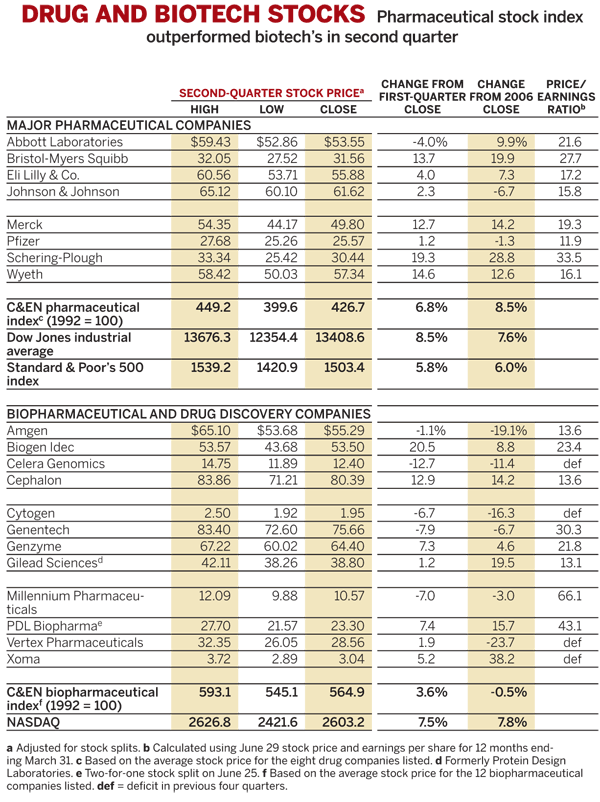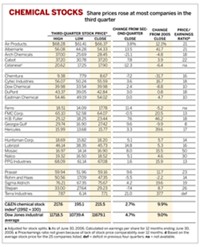Advertisement
Grab your lab coat. Let's get started
Welcome!
Welcome!
Create an account below to get 6 C&EN articles per month, receive newsletters and more - all free.
It seems this is your first time logging in online. Please enter the following information to continue.
As an ACS member you automatically get access to this site. All we need is few more details to create your reading experience.
Not you? Sign in with a different account.
Not you? Sign in with a different account.
ERROR 1
ERROR 1
ERROR 2
ERROR 2
ERROR 2
ERROR 2
ERROR 2
Password and Confirm password must match.
If you have an ACS member number, please enter it here so we can link this account to your membership. (optional)
ERROR 2
ACS values your privacy. By submitting your information, you are gaining access to C&EN and subscribing to our weekly newsletter. We use the information you provide to make your reading experience better, and we will never sell your data to third party members.
Business
Stocks climb in second quarter
Despite volatility, share prices rose; chemicals again beat drugs and biotechs
by William J. Storck
July 16, 2007
| A version of this story appeared in
Volume 85, Issue 29
FOR THE THIRD straight quarter, C&EN's chemical stock index, made up of 25 U.S. companies, beat not only drug and technology stock indexes but also the Dow Jones industrial average, the Standard & Poor's 500 index, and NASDAQ.
Stocks performed solidly, even though the second quarter was a time of tremendous ups and downs for the market. During the period, the Dow Jones experienced eight days in which it gained more than 100 points, the highest being 187.3 on June 12, and six days in which it lost more than 100 points. The most it lost was 198.9 on June 7. To put it another way, the Dow Jones rose or fell 100 points or more in one out of every five trading days in the quarter.
Chemical stocks were volatile as well, but they ended the quarter strongly. The C&EN index finished the second quarter at 275.5 (all C&EN indexes are 1992 = 100), 11.1% ahead of where it had been at the close of trading in March and 16.8% ahead of the 2006 close.
Meanwhile, C&EN's eight-company pharmaceutical index closed the quarter at 426.7, up 6.8% from the end of March and 8.5% better than at the end of last year. C&EN's index of 12 biotechnology firms closed June at 564.9, up 3.6% from the first quarter but down 0.5% from the last trading day of 2006. The closing indexes for both drug and biotechnology stocks were well below their quarterly highs.
Among the broadest and most quoted measures of the stock market, the Dow Jones industrial average gained 8.5% from the end of the first quarter, while the S&P 500 was up 5.8% and NASDAQ forged ahead 7.5%. Compared with the end of 2006, the Dow Jones rose 7.6%, while the S&P 500 gained 6.0% and NASDAQ rose 7.8%.
Among the 25 chemical companies in C&EN's index, just three posted stock price declines in the second quarter when compared with the last trading day in the January through March period. Albemarle's share price was down 6.8% to close the period at $38.53, Dow Chemical was off 3.6% to $44.22 per share, and Cabot slipped 0.1% to $47.68 per share.
Shares at DuPont, the second-largest company on the list, finished a little better than at industry leader Dow, rising 2.9% from the end of the first quarter to $50.84. For the first six months of 2007, though, Dow outstripped DuPont, with its share price rising 10.7% compared with just 4.4% for the Wilmington, Del.-based company.
Meanwhile, 13 of the companies saw their stock prices climb by double-digit percentages.
With investors betting on a big crop-planting season, the largest share price increases came at fertilizer producers Mosaic and Terra Industries. Mosaic's stock price jumped 46.4% to $39.02 per share, while Terra's stock increased 45.3% to $25.42 per share. For the first six months of 2007, Mosaic's stock rose 82.7%, while Terra's share price more than doubled, surging 112.2%.
The big surprise came near the end of the quarter when Basell offered $25.25 per share to acquire Huntsman Corp. This boosted Huntsman's share price on the final trading day of the period to $24.31 per share, 28.6% above the pre-offer price and 28.8% above the closing price for the first quarter.
STOCK PRICE performance among the eight firms making up the C&EN pharmaceutical index was not as strong as among the chemical companies. Price movement among the drug firms ranged from a 4.0% decline at Abbott Laboratories to a 19.3% improvement at Schering-Plough.
Two of the three biggest increases came at firms that have seen their share of troubles: Schering-Plough, which was all but written off by investors a few years ago, and Bristol-Myers Squibb, which has had regulatory challenges and is now viewed by some analysts as a takeover target.
The bulk of Schering-Plough's quarterly 19.3% gain to $30.44 per share came after the company released its 2007 first-quarter earnings statement in mid-April. The report showed a net income available to common shareholders of $543 million, an increase of 55% over the same quarter in 2006. This improvement came on a 17% increase in sales to $2.98 billion.
Stock in Bristol-Myers rose 13.7% in the quarter to $31.56 per share. One catalyst was the late-April announcement of a worldwide collaboration with Pfizer to develop and commercialize apixaban, an anticoagulant discovered by Bristol-Myers that is being studied for the prevention and treatment of a broad range of venous and arterial thrombotic conditions. At about the same time, the company said a Food & Drug Administration advisory panel had voted unanimously to recommend approval of a new indication for Avalide, as an initial treatment for hypertension.
Big stock price increases among the biopharmaceutical companies were few, with just two, Biogen Idec and Cephalon, showing double-digit increases. Biogen's stock price increased 20.5% to close the quarter at $53.50 per share. The company predicts that it will earn between $2.50 and $2.65 per share in 2007 compared with $2.29 in 2006.
Cephalon's stock price increase of 12.9% to $80.39 per share made its shares the most expensive on the C&EN list, eclipsing that of Genentech, where a 7.9% decline lowered its price to $75.66 per share. Cephalon's stock price was bolstered when its basic adjusted earnings per share for the first quarter came in at $1.45, well above the 90 cents to $1.00 the company forecast when it reported year-end 2006 results.
Genentech's share price fell on results that were considered to be less impressive than they had been in the past and on investor concerns over the company's product pipeline.
Amgen saw its stock fall 1.1% to $55.29 per share. The biotech industry sales leader has now experienced three straight quarter-to-quarter declines, for a nine-month stock price drop of 22.7%. Again, analysts are concerned over the sales potential for some of the company's products.
In the first week of the third quarter, the chemical index outstripped all of the other indexes, helped by more drama on the Huntsman stage as private equity firm Apollo Management's Hexion Specialty Chemicals unit came in with a competing bid of $27.25 per share. By Friday of that week, investors had bid Huntsman's stock price up to $28.00 per share, 15.2% higher than the second-quarter close. On the following Monday, Hexion increased its bid to $28.00 per share, matching the Friday closing price.
The C&EN chemical index in the first week of July rose 2.6%, while the pharmaceutical index increased 0.5% and that for the biotech stocks fell 0.7%.
The Dow Jones, the S&P 500, and NASDAQ rose 1.6%, 1.8%, and 2.4%, respectively.






Join the conversation
Contact the reporter
Submit a Letter to the Editor for publication
Engage with us on Twitter